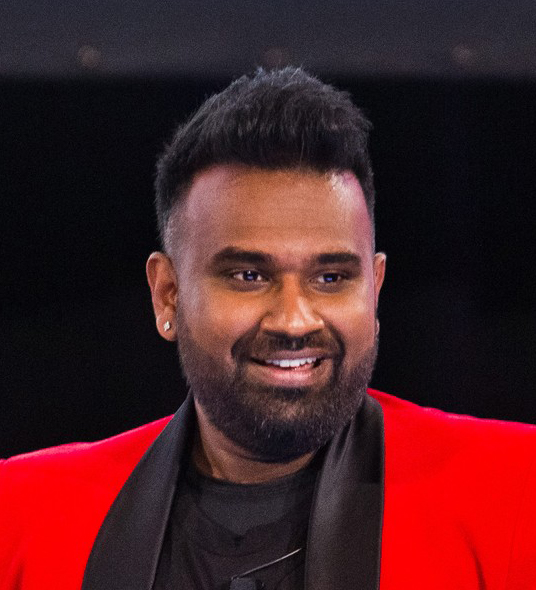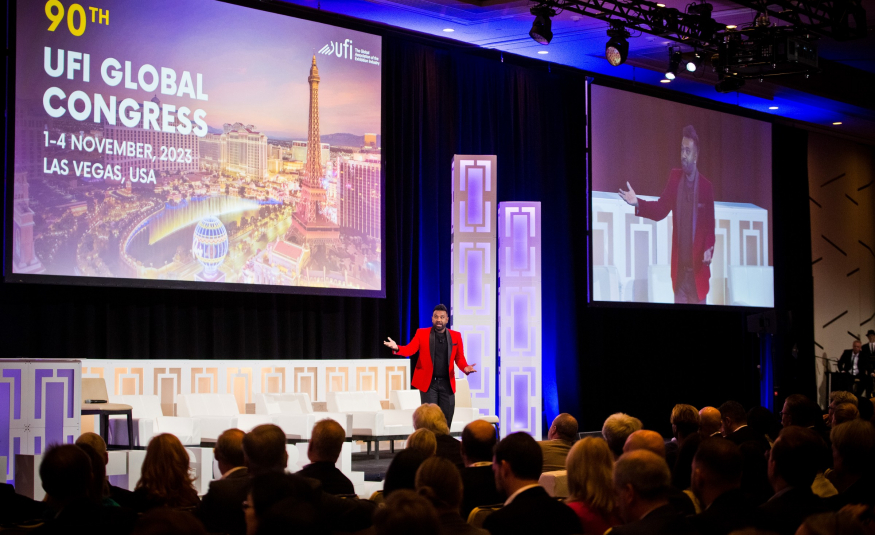Dan Ram was MC at UFI’s recent Las Vegas Global Congress. Paul Colston asks him about his experience there and thoughts on how to get messages across effectively and with creativity.
You were the MC for the recent UFI Congress in Las Vegas. How was it leading an event for the ‘event’ industry? Was there good energy in the room and how did you use that?
 DanRam: The energy in the room was incredible! It’s a combination of great friendships, anticipation for deep learnings and insights, as well as the ‘Vegas’ effect. And to be nominated as the event MC – an honour. I absolutely capitalised on the excitement by getting the 500-strong attendees on their feet to sing and dance along with our resident Vegas band, laugh along to our surprise opening keynote speaker (a Vegas and America’s Got Talent legend), and grabbing every creative opportunity to keep the audience engaged.
DanRam: The energy in the room was incredible! It’s a combination of great friendships, anticipation for deep learnings and insights, as well as the ‘Vegas’ effect. And to be nominated as the event MC – an honour. I absolutely capitalised on the excitement by getting the 500-strong attendees on their feet to sing and dance along with our resident Vegas band, laugh along to our surprise opening keynote speaker (a Vegas and America’s Got Talent legend), and grabbing every creative opportunity to keep the audience engaged.
Which keynote approach did you use for the UFI Congress and how did you feel that message was received and how can it be put into practice in our events sector?
Unpopular opinion – the exhibition industry is slow moving in a quickly changing world. Ever-evolving customer expectations are outpacing adoption of new innovation, exhibition business and revenue models haven’t changed in decades, and conference/event formats are basically the same wherever in the world you go. And yet it’s undeniable that exhibitions are absolutely essential (and valued) by industries and economies. So, how do we create the change we need and desire? My mantra ‘Start Now Start Simple’ probably best summarises my view – the best time to change is right now and the best way to change is baby steps – keep it simple.
What do you believe are growth opportunities for the events and exhibitions industry?
Facilitated networking, local experiences, and differentiation are key to turning attendees into ambassadors. Let’s be honest – most of the content and information at events can be found online, so in my humble opinion the REAL reason people attend an event is for the personal connection and for once-in-a-lifetime experiences. As MC, I often facilitate speed networking, matchmaking activities and gamified connection moments from the stage so that attendees walk away with high-value contacts. While agendas and programmes are usually packed with incredible content, what attendees ultimately remember and share are special experiences.
I encourage event and exhibition organisers to integrate local culture, cuisine, and community both in the main programme as well as in the evening line-up. And while there is safety in copying best practices from around the world, the greatest reward goes to those who lead the pack and that can only happen by differentiating.
As an MC I am committed to the desired culture and results of the clients who hire me but am also bold to recommend new approaches, new technology and new formats in the hopes that it creates higher ROI for the event.
What are some of the mistakes that speakers and MCs make? Can everybody improve their on stage performance or is part of the technique in-built?
It’s undeniable that we are all competing for attention. One redundant sentence, a small delay due to tech failure, or poor programming and the phones are out, screens are on and attention is gone. The ultimate technique to getting and keeping attention is... engagement! My rule of thumb is to engage audiences every 5-7mins. I coach TEDx speakers and keynote speakers on enhancing storytelling, integrating audience engagement and keeping attention. It’s absolutely learnable!
Can you give some examples from the many events you have worked on and emceed where delegates/speakers have adopted your methods and achieved better results?
The best example is probably panels – the dullest of all formats on stage. It’s such a missed opportunity because usually the line-up is extraordinary and the subject matter of direct relevance to the audience. When you make audience engagement core to the planning of a panel you can immediately throw out the typical format of four interview questions that each panelists answers in individual monologues. My panel format intentionally involves variety in the hopes to maintain engagement. I start with rapid fire questions where panelists can only answer with one word; play a game of ‘overhyped or underhyped’ with topics crowdsourced from the audience; ask one specific and distinct question for each panelist which then opens up nicely to a group debate. I usually then physically go into the audience to change the focal point and take questions from the audience. And then repeat. Variety and novelty are core ingredients here that make this panel format more engaging.
Who are some of the most effective celebrity presenters and effective speakers you have met during your career and how do they achieve their successes? Presumably there is a variety of successful techniques dependent on personality and environment?
I remember President Obama being poised, dignified and intentional with every word placement, slow-paced but purposeful. On the other hand Gary Vaynerchuck’s fast-paced, off-the-cuff, direct-from-the-heart delivery keeps the audience barely holding on. Chris Barton’s personal story of how perseverance against all odds led to the founding of Shazam is effective because it’s authentic. Ultimately the ‘right way’ is whatever style or technique is relevant and relatable.
What did you learn from our UFI Congress delegates and the exhibition sector and its power to spark debate, deals and innovation?
The data shared on future trends was truly fascinating. What a rich resource for event organisers to have access to this information and make calculative decisions to give them a competitive advantage!
It’s incredible that the UFI network includes researchers and experts who are able to collect and analyse data from all across the world to reveal deep insights and new opportunities.
Can you give us your top five lasting tips as takeaways for effective presenting?
- Hook > Intro. The primary goal of the start of your talk is to GET attention. So, drop the typical introduction and start instead with an anecdote that creates and emotional response from the audience.
- Emotion > Content. Beyond knowing your content, you need to be intentional about bringing the audience through an emotional journey to maintain attention. Think like a Netflix producer and not a college professor.
- Story > Statistics. Not only will you be more authentic in communicating personal anecdotes and stories than facts and figures, it’s also more memorable.
- Surprise > Predictable. In a world of Powerpoint, use props instead. With majority of speakers standing behind a podium, step into the centre of the stage. Re-introduce analogue when everyone is expecting digital.
- And finally, have fun! People will forget what you will say, but they won’t forget how you made them feel. Passion goes a long way!
DanRam Event MC| 6x TEDx Speaker | Public Speaking Coach
DanRam travels the globe as an Event MC & Speaker at over 100 events a year. He has hosted changemakers including President Barack Obama, Sir Richard Branson and F1 champion Nico Rosberg. He works on four continents, from college campuses to parliaments, to in-house corporate innovation days for Fortune 500 companies to the biggest tech conferences in the world. His passion is to inspire people with his motto ‘Start Now Start Simple’ in building a future we all want to live in.





